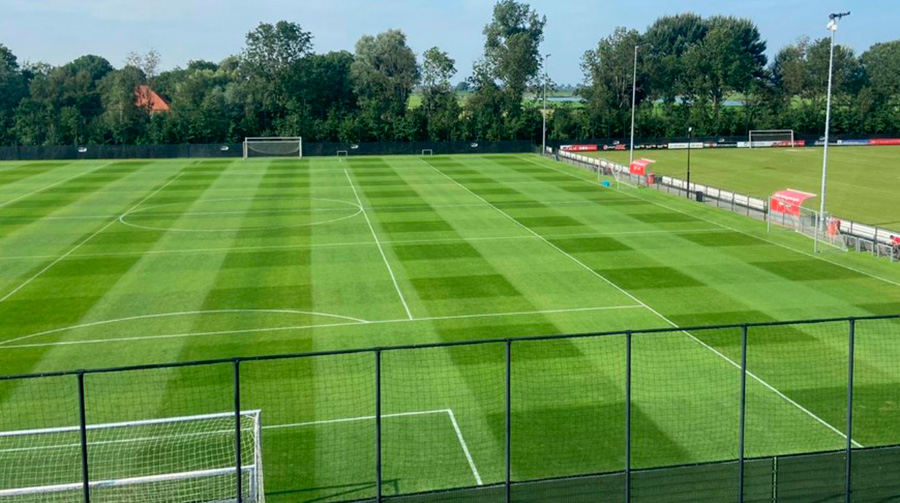- English

The Aqua4D water system leased by Lescrauwaet BV has made a significant contribution to solving the problems with the grass on the training fields of the AFAS Training Complex in Wijdewormer. “We now have no more dead grass patches. That’s because the water system creates smaller water droplets, getting them into the smallest pores,” says groundsman Wouter Uitentuis.
“In the first year the training fields were completed, five years ago now, no one could have imagined how poorly the grass would grow. Many bare grass patches appeared, especially near the overlap of the sprinklers.” After the first season, a fieldtop maker milled off 2 cm of the grass layer, reseeded and fertilized. Due to the hot and dry summer the following year, the emerging grass burned immediately. Uitentuis: “We then wondered what caused that and started looking. We found out that it had to do with the salty pouring water. With this knowledge, we started spraying the fields much more to push away the salt. Sometimes as much as 40 to 50 ml/m2 per night. Normally, depending on the time of year, we give between 10 and 15 ml/m2.”
Ball needed to roll faster
After a large amount of water, there was no watering for several days until the turf started to dry out. That was the time to start watering again. “As a result, it took longer than desired, including from the club, before there was still a reasonable turf. But at the overlap spots of the sprinklers we saw that the grass did not want to grow as a result of the silted ground,” says the groundsman, who manages the training fields full-time.
A second problem arose. From AZ came the request, for the sake of ball speed, to also wet the fields during the day. “To wet the grass then, we had to spray water in small turns even on a sunny summer day. This leaves the salty water on the blades of grass. As a result, especially the salt residue left behind burned into the leaves, causing the grass to turn yellow and die.” Later in the season, more rain did turn the grass green again. “Once the grass received fresh rainwater, the grass was back to its normal green color with a week,” he said.
Looking for an adequate system
To remove the salt from the irrigation water (EC value 7), a reverse osmosis plant was considered. But this system could not handle the amount of water from the 60 m3/hour pump. Tap water was also not an option because there was no connection to be made that was adequate. Moreover, drinking water is expensive.
Two years ago, the groundsman called in Westhoven Agro Advies. They put him in touch with Aqua4D BeNeLuxDu importer Lescrauwaet BV in Hilversum for treatment of the surface water. With the Aqua4D water system, irrigation water is treated with electromagnetic signals, improving or refining its molecular structure. Meanwhile, according to the manufacturer, more than 4,200 water systems are operational in over 40 countries in both horticulture including sports fields, livestock and buildings.
First, a test was done by connecting and disconnecting sprinklers to the Aqua4D water system. Uitentuis: “At first we were skeptical, because we thought no system could do it right. But we soon saw a difference with Aqua4D. With the sprinklers whose water had not undergone treatment, the grass quickly burned.”
Smaller droplets roll off leaves
According to the groundsman, this water system has the capacity needed, is affordable and has a positive effect on bare grass areas. “The water surface tension is lower, so the water droplets are smaller and less spherical. We also see this in the water that sprays more when watering the grass. Because of the change in water molecules, the water droplets no longer stay on the leaf. Because they roll off, we also no longer have salt residue. As a result, the grass no longer burns.”
View entire picture
The Aqua4D watering system has made a significant difference in the grass patches that did not want to grow. “Every year is different. It can be warmer or colder, more or less sunlight and drier or wetter. Water is one facet out of the whole picture, but the most important one. In summer we now have a different fertilization policy with more coated fertilizers, which are released slowly, and we spray urea fertilizer on the leaves. Since a few years we also apply Solar, a kind of sunburn for on the leaves. Should fertilizer then remain on the leaf, there is no burn-in,” Uitentuis said.
The groundsman also adds CO2 to the irrigation water to lower the pH, which improves nutrient uptake. “The pH is too high due to acidification and is currently at 8.5. For grass, the ideal pH is 5.5 to 6. Still, we are pleased with the beautiful green turf this summer. It really is a picture.”